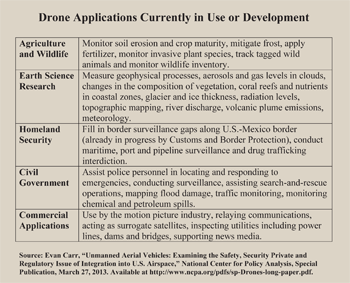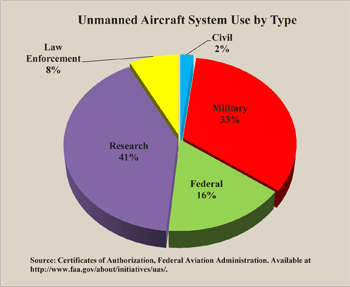Unmanned aerial vehicles, commonly known as drones, date back to the dawn of modern aviation at Kittyhawk. Modern drones have come about through a combination of technological advancements, including the refinement of propulsion methods, expansion of wireless capabilities, digitization of avionics, wide-band data transmission and the increased capabilities of satellite-based Global Positioning System navigation.
They vary in size and price from small, unmanned aerial systems, which span only a few feet across and cost less than $1,000, to High-Altitude Long-Endurance drones like the Global Hawk, which is the size of a 50-passenger commercial airliner and costs an estimated $173 million.1 Having only entered the public eye following their use in the War on Terror, drones are poised to redefine the aviation industry and drive substantial economic growth.
Integrating Drones with Existing Aviation. Though many safety, security and privacy challenges must be overcome before drones can be integrated into the National Airspace System, the Federal Aviation Administration (FAA) has begun drafting regulations that will allow the transfer of technology from the military sector to the civilian sector. The FAA regulates all aspects of aviation in the United States. The FAA Modernization and Reform Act of 2012 set a September 2015 deadline for full integration of civilian drones into American skies,2 anticipating up to 30,000 drones operating by 2020.3
The FAA must achieve several objectives to support integration:
- The FAA must regulate air traffic so that aircraft separated spatially by time and altitude pose minimal risk to people and property on the ground or in the air.
- The administration must also certify the air worthiness of unmanned craft and streamline the Certificate of Authorization process.
- The FAA must continue the installation of the NextGen air traffic control system — updating America’s antiquated radar-based system with a more efficient satellite-based system.
Given the complexity of integration, some observers doubt the FAA can meet the 2015 deadline because it has missed numerous interim deadlines.4
Industry Growth. According to the consulting firm Deloitte, the economic impact of developing unmanned technology will be substantial, particularly for aviation clusters in Texas and the Northwest.5 The Teal Group, a leading aerospace market intelligence firm, says that despite cuts in defense spending, annual global spending on drones will grow from $5.9 billion in 2012 to $11.3 billion in 2021.
The Defense Advanced Research Projects Agency funds a crowdsourcing competition called the UAVForge. The 2012 competition highlighted the decentralized, entrepreneurial nature of unmanned development: More than 140 teams and 3,500 people from 153 countries participated in the competition.6 Many applications of drone platforms are in some phase of research, development, testing, evaluation or operation, and the industry will likely generate a new wave of entrepreneurs.
The unmanned industry is already creating jobs. The Association of Unmanned Vehicle Systems International (AUVSI) has been instrumental in highlighting the many merits of drones. In addition to holding technology workshops and web-based seminars, AUVSI holds an annual conference that brings together more than 570 exhibitors with delegates from more than 40 countries. Due in part to AUVSI’s contribution to discussion of unmanned capabilities, both the U.S. House of Representatives and the U.S. Senate now have unmanned aerial vehicle caucuses that aim to increase legislators’ knowledge about this growing industry.7

Spillovers from existing technologies will allow drones to be retrofitted for a variety of purposes. Indeed, the future of the drone lies with a multitude of domestic civilian functions. [See the table.]
New technologies will require both existing firms and new entrepreneurs to develop solutions that could drive economic growth for decades to come. Among the developments that must occur if drones are to be widely used:
- New technologies must enable drones to “see-and-avoid” other manned aircraft — essential in order to avoid costly mid-air collisions.
- To ensure security, developers must perfect secure data and video links that connect the drones to operators at ground control stations.
- Global Positioning Satellite signals must be secured and/or encrypted to prevent “spoofing,” which makes a drone think it is in a different location and transfers control of the vehicle to a hacker — a threat demonstrated by a University of Texas at Austin team in 2012.8
- Adequate redundancy must be built into the platforms to prevent mechanical and electrical failures.
- “Lost-link” protocols must be developed and tested in the event the link between the drone and ground control station is severed.9
Prior to full civilian integration, the FAA has issued 413 Certificates of Authorization that allow federal, state and local government entities to operate drones [see the figure]:
- Two percent are for civil uses like fighting forest fires and topographic mapping.
- A third have been issued to military agencies, including the U.S. Air Force, U.S. Marines and U.S. Army.
- Another 16.5 percent are for nonmilitary federal agencies like the U.S. Department of Agriculture and the U.S. Department of Energy.
- Universities conducting drone research received some 41 percent.
- Thus far, domestic law enforcement agencies have received 7.5 percent of the certificates.10
Currently, the FAA is seeking input from the public and interested stakeholders on where to develop six new testing sites.11 The location of the six testing sites should bring significant investment and economic development to the regions selected.

Potential for Abuse. The U.S. government has not set any limits on drone operations. The array of drone capabilities creates considerable concern that unmanned technology might be used to circumvent Americans’ constitutional protections. Consider:
- More than 350 U.S. drone attacks in Pakistan alone have killed an estimated 265 civilians and 2,096 militants.12
- The 2011 U.S. drone attack in Yemen killed Anwar al-Awlaki, an American citizen placed on a “targeted kill” list for his links to terrorism.13
- A standoff in North Dakota was the first publicized instance in which a drone was used in apprehending a U.S. citizen.14
- In February 2013, journalists speculated that drones were used in the search for Christopher Dorner, a high-profile target in California who killed four police officers.15
The Constitution’s Fourth Amendment guarantees citizens freedom from unreasonable search and seizure. Many people feel that drone surveillance infringes Fourth Amendment rights. Therefore, strict privacy protections must be implemented before the public will support drone use in domestic airspace. No court has yet addressed Fourth Amendment considerations with respect to drones, but existing jurisprudence provides guidance for future rulings. Among the applicable court decisions:
- In the case of California v. Ciraolo (1986), a California appeals court found that an individual’s private property is not protected by the Fourth Amendment as long as an aircraft is in navigable airspace.16
- In Dow Chemical Co. v. United States (1986), the U.S. Supreme Court ruled that photography by government agents using equipment readily available to the public does not require a warrant.17
- Following Dow, in Kyllo v. United States (2001), the Supreme Court held that warrantless surveillance through extra-sensory equipment such as a thermal imaging device is also permissible.18
Conclusion. With full integration fast approaching, discussion must focus on the civilian, commercial and scientific applications of drones, as well as limits on how this new technology can be used. The FAA is responsible for establishing a system that ensures safety without hindering development. While the regulatory and technical hurdles may delay the eventual date of full integration, public hostility towards drones will continue as long as transparency issues damage the government’s credibility. With substantial economic growth at stake, proper safeguards must be established to provide protection from overzealous government.
Evan Baldwin Carr is a research associate with the National Center for Policy Analysis.
Endnotes
1. Lee Ferran, “Air Force Shelves $3B Worth of Brand New Drones,” ABC News, March 2, 2012. Available at http://abcnews.go.com/Blotter/global-hawk-air-force-shelves-3b-worth-unmanned/story?id=15828636.
2. FAA Modernization and Reform Act of 2012, Sections 331 through 337. Available at http://www.gpo.gov/fdsys/pkg/CRPT-112hrpt381/pdf/CRPT-112hrpt381.pdf.
3. Ben Wolfgang, “FAA chief says drones will force change at agency,” Washington Times, August 7, 2012. Available at http://www.washingtontimes.com/news/2012/aug/7/faa-chief-says-drones-will-force-change-at-agency/.
4. “Measuring Progress and Addressing Potential Privacy Concerns Would Facilitate Integration into the National Airspace System,” Government Accountability Office, September 2012, pages 23-29. Available at http://www.gao.gov/products/GAO-12-981.
5. “The Aerospace and Defense Industry in the U.S.,” Deloitte Consulting Services. Available at http://www.deloitte.com/view/en_US/us/Industries/Aerospace-Defense-Manufacturing/b4c8ae98118f5310VgnVCM3000001c56f00aRCRD.htm.
6. UAVForge. Available at http://www.uavforge.net/.
7. Congressional Unmanned Systems Caucus. Available at http://unmannedsystemscaucus.mckeon.house.gov/. See also Stephen Dinan,“Senators Form Drone Caucus,” Washington Times, September 28, 2012. Available at http://www.washingtontimes.com/blog/inside-politics/2012/sep/28/senators-form-drone-caucus/.
8. “Cockrell School Researchers Demonstrate First Successful ‘Spoofing’ of UAVs,” Cockrell School of Engineering, 2012. Available at http://www.engr.utexas.edu/features/humphreysspoofing.
9. “Unmanned Systems Integrated Roadmap: FY 2009-2034,” Department of Defense, April 2009. Available at http://www.dtic.mil/cgi-bin/GetTRDoc?Location=U2&doc=GetTRDoc.pdf&AD=ADA522247.
10. Certificates of Authorization, Federal Aviation Administration. Available at http://www.faa.gov/about/initiatives/uas/.
11. Associated Press, “FAA seeks proposals for 6 sites to test drones over US skies, outlines plan to protect privacy,” Washington Post, February 14, 2013. Available at http://www.washingtonpost.com/politics/faa-seeks-proposals-to-create-6-drone-test-sites-offers-plan-to-protect-privacy-from-drones/2013/02/14/23164162-76e6-11e2-b102-948929030e64_story.html.
12. “The Year of the Drone,” New America Foundation, 2013. Available at http://counterterrorism.newamerica.net/drones.
13. Andrew Rafferty, “American drone deaths highlight controversy,” NBC News, February 5, 2013. Available at http://usnews.nbcnews.com/_news/2013/02/05/16856963-american-drone-deaths-highlight-controversy?lite.
14. “Rodney Brossart, American Arrested Using Predator Drone, Had Rights Violated, Lawyer Says,” Huffington Post, May 4, 2012. Available at http://www.huffingtonpost.com/2012/05/04/rodney-brossart-american-arrested-using-predator-drone_n_1477549.html.
15. “Drones Targeting Chris Dorner? LAPD Won’t Confirm UK Report,” Huffington Post, February 11, 2013. Available at http://www.huffingtonpost.com/2013/02/11/christopher-dorner-drones_n_2663871.html.
16. California v. Ciraolo. Available at http://www.law.cornell.edu/supct/html/historics/USSC_CR_0476_0207_ZS.html.
17. Dow Chemical Company v. United States. Available at http://www.law.cornell.edu/supremecourt/text/476/227.
18. Kyllo v. United States. Available at http://www.oyez.org/cases/2000-2009/2000/2000_99_8508.